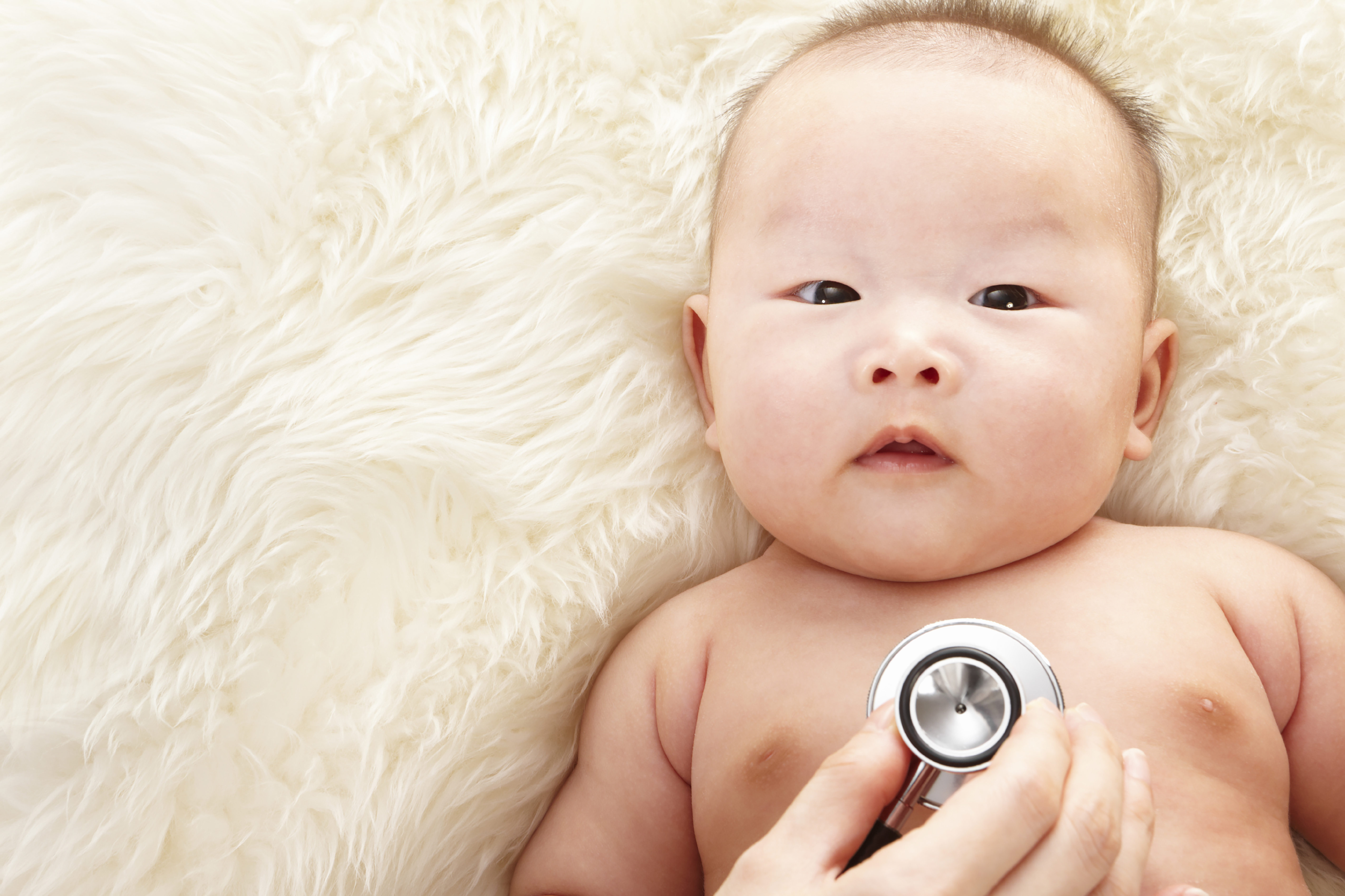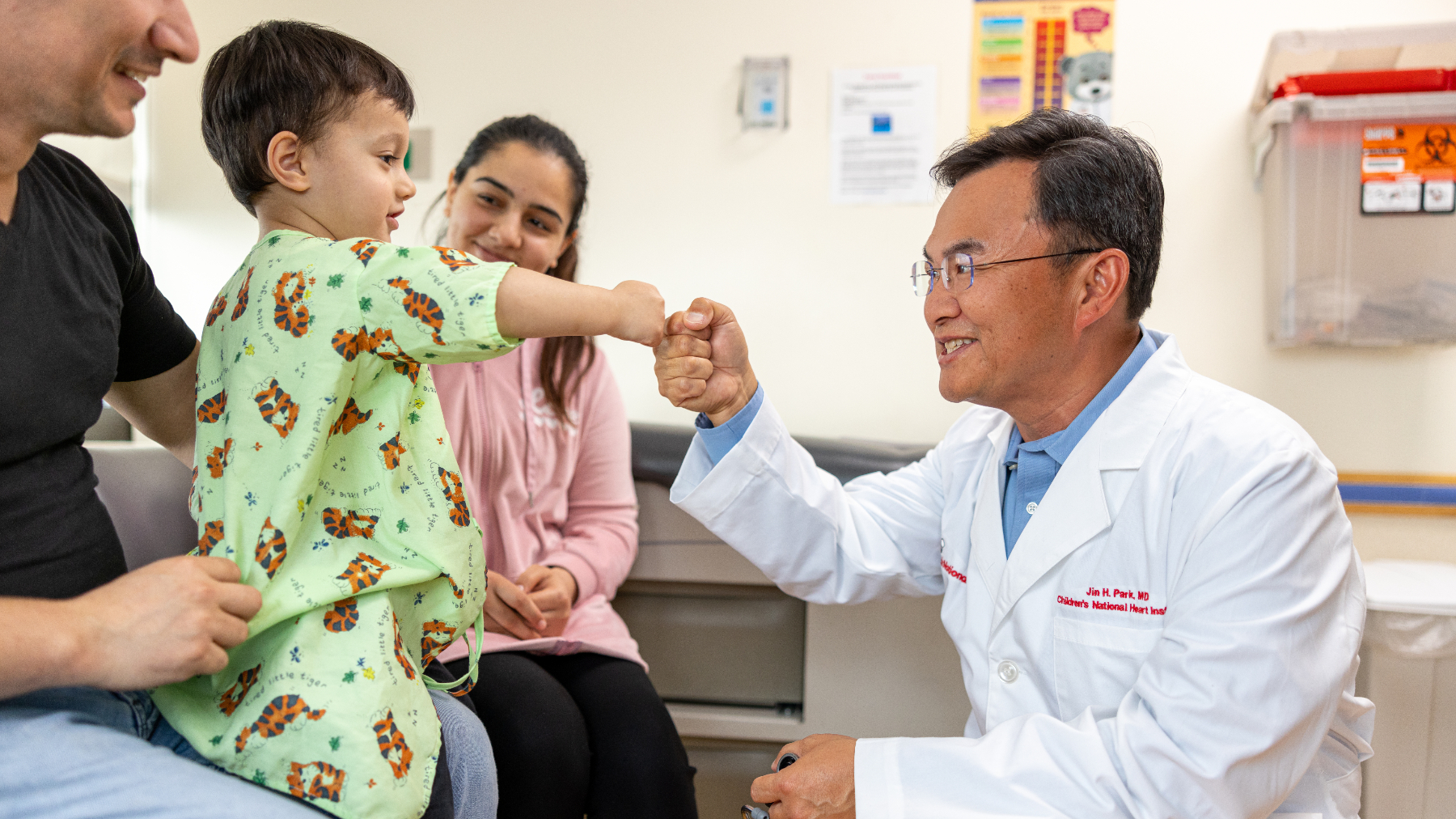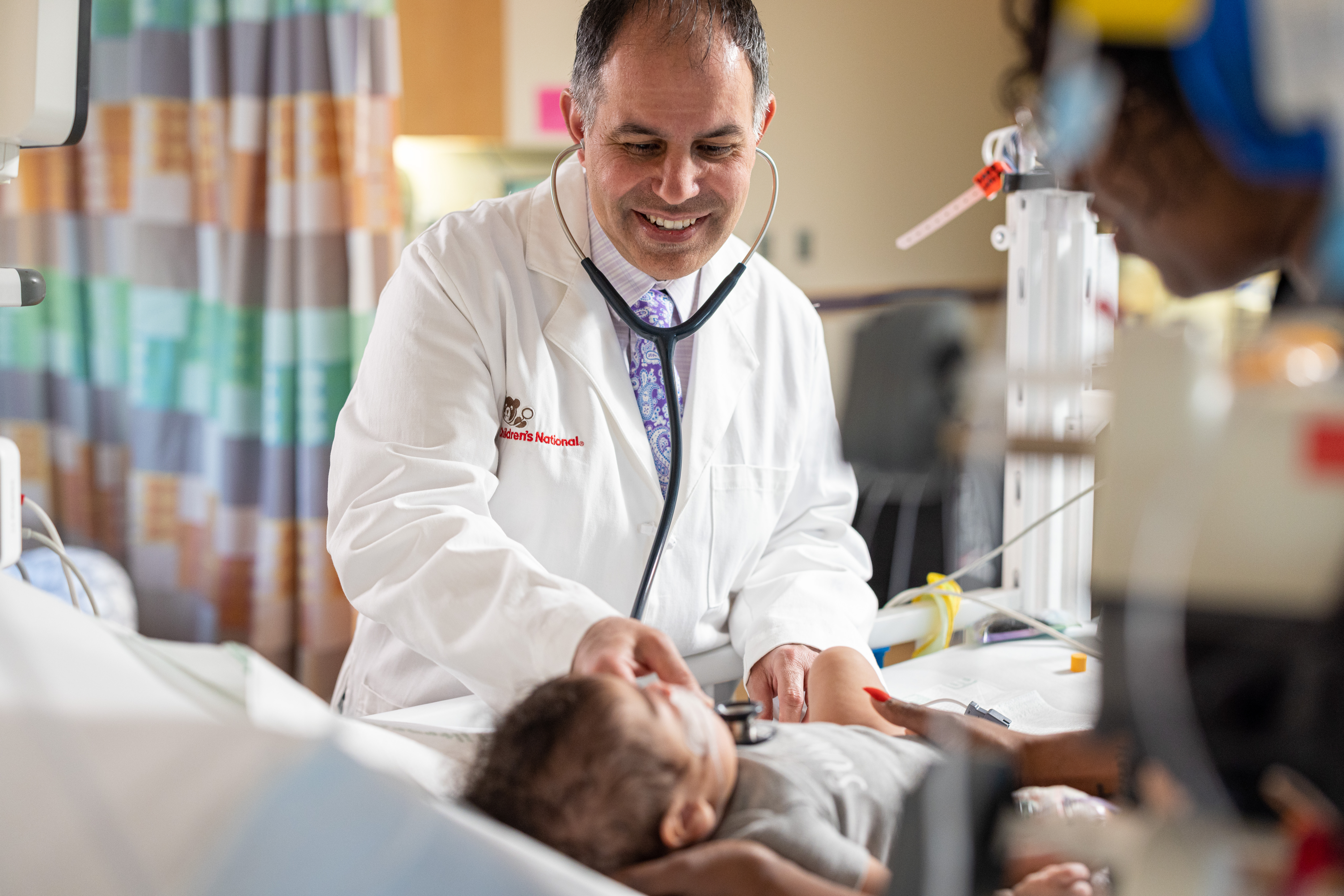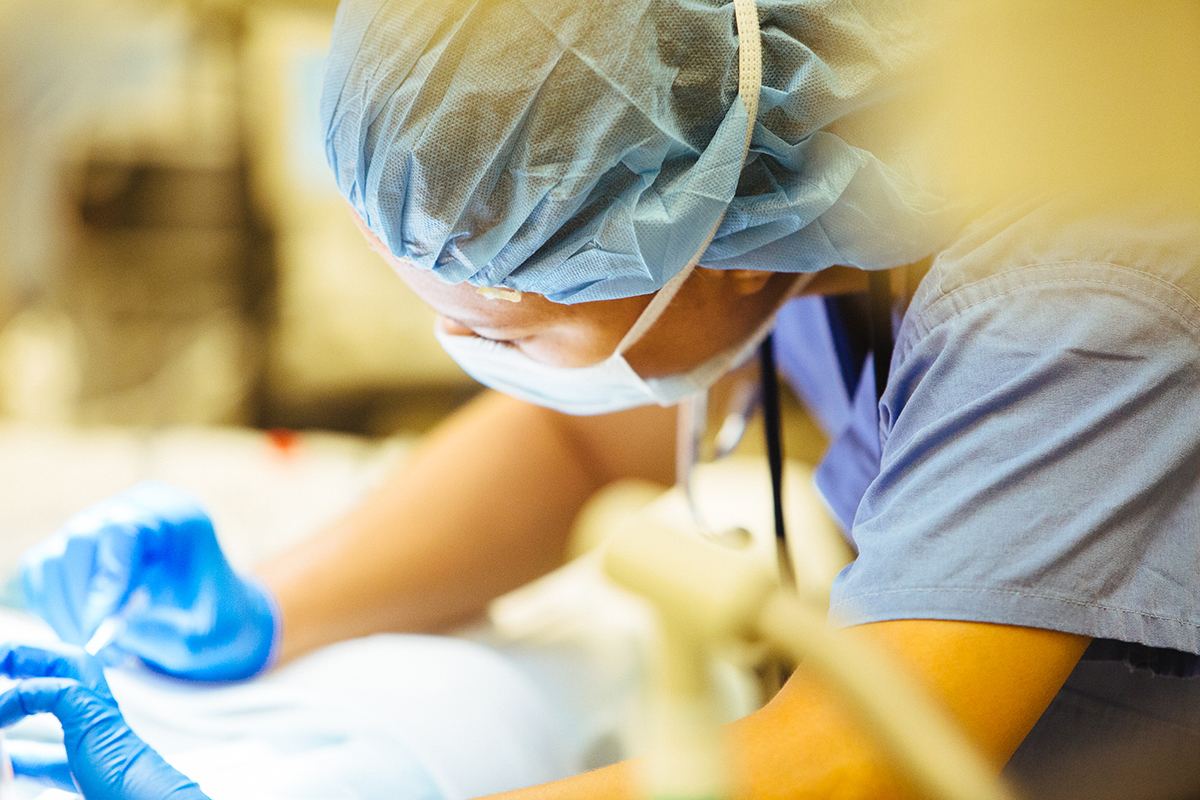Condition
Pediatric Aortic Stenosis
What You Need to Know
Aortic stenosis is the inability of the aortic valve to open completely.
Key Symptoms
The most common symptoms of aortic stenosis are:
- Fatigue
- Dizziness with exertion
- Shortness of breath
- Irregular heartbeats
- Chest pain
Diagnosis
Doctors typically diagnose aortic stenosis by:
- Physical exam
- Chest X-ray
- Electrocardiogram (ECG or EKG)
- Echocardiogram (echo)
- Cardiac MRI
- Cardiac catheterization
Treatment
Aortic stenosis is treated with repair of the obstructed valve. Several options are currently available.
- Balloon dilation
- Valvotomy
- Aortic valve replacement
- Pulmonary autograft (Ross procedure)
- Aortic homograft
Schedule an Appointment
Our pediatric specialists provide personalized care for your child’s physical, mental and emotional health needs. Meet our providers and schedule an appointment today.
Frequently Asked Questions
What is aortic stenosis?
Aortic stenosis is a heart defect that may be present at birth (congenital) or it may develop later in life (acquired). If the problem is congenital, then the defect developed during the first 8 weeks of pregnancy.
The aortic valve is found between the left ventricle and the aorta. It has three leaflets that function like a one-way door, allowing blood to flow forward into the aorta, but not backward into the left ventricle. Aortic stenosis is the inability of the aortic valve to open completely.
With aortic stenosis, problems with the aortic valve make it harder for the leaflets to open and permit blood to flow forward from the left ventricle to the aorta. In children, these problems can include a valve that:
- Only has two leaflets instead of three (bicuspid aortic valve)
- Has leaflets that are partially fused together
- Has thick leaflets that do not open all the way
- Becomes damaged by rheumatic fever or bacterial endocarditis
- In addition, the area above or below the valve can be narrowed (supravalvar or subvalvar aortic stenosis)
Aortic stenosis may be present in varying degrees, classified according to how much obstruction to blood flow is present. A child with severe aortic stenosis will be quite ill, with major symptoms noted early in life. A child with mild aortic stenosis may have few symptoms, or perhaps none at all until later in adulthood. The degree of obstruction can become worse with time.
Congenital aortic stenosis occurs in a small percentage of children with congenital heart disease. Relatively few children have symptoms as an infant, but problems increase sharply in adulthood.
Congenital aortic stenosis occurs three times more often in boys than in girls.
What causes aortic stenosis in children?
Congenital aortic stenosis occurs due to improper development of the aortic valve in the first eight weeks of prenatal growth. It can be caused by a number of factors, though, most of the time, this heart defect occurs sporadically (by chance), with no apparent reason for its development.
Some congenital heart defects may have a genetic link (defective gene), causing heart problems to occur more often in certain families.
Acquired aortic stenosis may occur after a strep infection that progresses to rheumatic fever.
Why is aortic stenosis a concern for children?
Mild aortic stenosis may not cause any symptoms. Several problems may occur, however, when aortic stenosis is moderate to severe, including the following:
- The left ventricle has to work harder to try to move blood through the tight aortic valve. Eventually, the left ventricle is no longer able to handle the extra workload, and it fails to pump blood to the body efficiently
- There is a higher than average chance that the aorta may become enlarged. This can increase the risk of an aneurysm or dissection of the aorta
- There is a higher than average chance of developing an infection in the lining of the heart or aorta known as bacterial endocarditis
- The coronary arteries, which supply oxygen-rich (red) blood to the heart muscle, may not receive enough blood to meet the demands of the heart
What are the symptoms of aortic stenosis in children?
The following are the most common symptoms of aortic stenosis. However, each child may experience symptoms differently. Symptoms may include:
- Fatigue
- Dizziness with exertion
- Shortness of breath
- Irregular heartbeats or palpitations
- Chest pain
The symptoms of aortic stenosis may look like other medical conditions or heart problems. Always consult your child's doctor for a diagnosis.
How is aortic stenosis diagnosed in children?
Your child's doctor may have heard a heart murmur during a physical exam and referred your child to a pediatric cardiologist for a diagnosis. In this case, a heart murmur is a noise caused by the turbulence of blood flowing through the obstruction from the left ventricle to the aorta. Symptoms your child exhibits will also help with the diagnosis.
A pediatric cardiologist specializes in the diagnosis and medical management of congenital heart defects, as well as heart problems that may develop later in childhood. The cardiologist will do a physical exam, listen to your child's heart and lungs, and make other observations that help in the diagnosis. The location within the chest that the murmur is heard best, as well as the loudness and quality of the murmur (harsh, blowing, etc.) will give the cardiologist an initial idea of which heart problem your child may have. Diagnostic testing for congenital heart disease varies by the child's age, clinical condition and institutional preferences. Some tests that may be recommended include the following:
- Chest X-ray. A test which uses X-ray beams to produce images of internal tissues, bones and organs onto film
- Electrocardiogram (ECG or EKG). A test that records the electrical activity of the heart, shows abnormal rhythms (arrhythmias or dysrhythmias), and detects heart muscle stress
- Echocardiogram (echo). A procedure that evaluates the structure and function of the heart by using sound waves recorded on an electronic sensor that produce a moving picture of the heart and heart valves
- Exercise electrocardiogram (ECG). An exercise ECG is done to assess the heart's response to stress or exercise. The ECG is monitored while your child is exercising on a treadmill or stationary bike. An EKG measures the electrical activity of your child's heart
- Cardiac MRI. A diagnostic procedure that uses a combination of large magnets, radiofrequencies and a computer to produce detailed images of the heart
- Cardiac catheterization. A cardiac catheterization is an invasive procedure that gives very detailed information about the structures inside the heart. Under sedation, a small, thin, flexible tube (catheter) is inserted into a blood vessel in the groin and guided to the inside of the heart. Blood pressure and oxygen measurements are taken in multiple chambers of the heart, as well as the pulmonary artery and aorta. Contrast dye is also injected to more clearly visualize the structures inside the heart
What is the treatment for aortic stenosis in children?
Specific treatment for aortic stenosis will be determined by your child's doctor based on:
- Your child's age, overall health and medical history
- Extent of the disease
- Your child's tolerance for specific medications, procedures or therapies
- Expectations for the course of the disease
- Your opinion or preference
Aortic stenosis is treated with repair of the obstructed valve. Several options are currently available.
Some infants will be very sick, require care in the intensive care unit (ICU) prior to the procedure, and could possibly even need emergency repair of the aortic stenosis. Others, who have few symptoms, will have the repair scheduled on a less urgent basis.
Some children with severe stenosis may have activity or exercise restricted prior to repair. For instance, competitive sports that require endurance or intense activity, such as weightlifting, may be restricted.
Repair options include the following:
- Balloon dilation. A cardiac catheterization procedure in which a small, flexible tube (catheter) is inserted into a blood vessel in the groin, and guided to the inside of the heart. The tube has a deflated balloon in the tip. When the tube is placed in the narrowed valve, the balloon is inflated to stretch the area open.
- Valvotomy. This is surgical release of scar tissue within the aortic valve leaflets that are preventing the valve leaflets from opening properly.
- Aortic valve replacement. The aortic valve is replaced with a new valve. Replacement valves fall into two categories: Tissue (biological) valves, which are made from animal tissues and valves. The valve leaflets are soft and thin. On the other hand, mechanical valves, which are made from carbon fibers, have solid valve leaflets. Children who have had a valve replacement will need to follow antibiotic prophylaxis throughout their lifetime. People who have received a mechanical valve will need life-long treatment with Coumadin (warfarin), a medication that thins the blood to prevent catastrophic clots from forming on the valve leaflets themselves.
- Pulmonary autograft (Ross procedure). A section of the child's own pulmonary artery, with the pulmonary valve intact, is used to replace the aortic valve and a section of the ascending aorta. A section of pulmonary artery from another human donor with its valve intact is used to replace the transferred pulmonary artery.
- Aortic homograft. A section of aorta from a human donor, with its aortic valve intact, is used to replace the aortic valve and a section of the ascending aorta. This procedure is seldom done due to the complexity of the operation and the rapid failure of the aortic homograft itself.
How can I care for my child after surgery for aortic stenosis?
If your child needs surgery, he or she will go to the intensive care unit (ICU) after the procedure. While your child is in the ICU, special equipment will be used to help him or her recover from surgery, and may include the following:
- Ventilator. This is a machine that helps your child breathe while he or she is under anesthesia during the operation. A small, plastic tube is guided into the windpipe and attached to the ventilator, which breathes for your child while he or she is too sleepy to breathe effectively. Many children remain on the ventilator for a while after surgery so they can rest.
- Intravenous (IV) catheters. Small, plastic tubes inserted through the skin into blood vessels to provide IV fluids and important medicines that help your child recover from the operation.
- Arterial line. A specialized IV placed in the wrist or other area of the body where a pulse can be felt, that measures blood pressure continuously during surgery and while your child is in the ICU.
- Nasogastric (NG) tube. A small, flexible tube that keeps the stomach drained of acid and gas bubbles that may build up during surgery.
- Urinary catheter. A small, flexible tube that allows urine to drain out of the bladder and accurately measures how much urine the body makes. This can help determine how well the heart is functioning. After surgery, the heart may initially be a little weaker than it was before, and, therefore, the body may start to hold onto fluid, causing swelling and puffiness. Diuretics may be given to help the kidneys remove excess fluid from the body.
- Chest tube. A drainage tube may be inserted to keep the chest free of blood that would otherwise accumulate after the incision is closed. Bleeding may occur for several hours or even several days after surgery.
- Heart monitor. A machine that constantly displays a picture of your child's heart rhythm and monitors heart rate, arterial blood pressure and other values.
Your child may need other equipment not mentioned here to provide support while in the ICU or afterwards. The hospital staff will explain all of the necessary equipment to you.
Your child will be kept as comfortable as possible with several different medications; some of which relieve pain and some of which relieve anxiety. The staff will also be asking for your input as to how best to soothe and comfort your child.
After discharge from the ICU, your child will recuperate on another hospital unit for a few days before going home. You will learn how to care for your child at home before your child is discharged. Your child may need to take medications for a while and these will be explained to you. The staff will give you instructions regarding medications, activity limitations and follow-up appointments before your child is discharged.
What is the long-term outlook for my child after aortic stenosis surgical repair?
Most children who have had an aortic stenosis surgical repair will live healthy lives. Activity levels, appetite and growth should eventually return to normal.
As the child grows, a valve that was ballooned may once again become narrowed. If this happens, a second balloon procedure or operation may be necessary to repair aortic stenosis. Sometimes the aortic tissue itself may be abnormal, which might lead to complications in the teen or adult years. Regular follow-up care at a specialized cardiac center should continue throughout life.
Your child's cardiologist may recommend that antibiotics be given to prevent bacterial endocarditis after discharge from the hospital.
People who had a mechanical valve replacement may need to take anticoagulants (blood thinners) to prevent blood clots from forming on the artificial valve surfaces. Regular monitoring of the blood’s clotting status is very important in maintaining the most appropriate dose of anticoagulants.
Initial valve replacement is often done using a tissue valve to avoid the need for anticoagulation, especially for females of childbearing age. Anticoagulation during pregnancy is very difficult to manage and requires special treatment.
Repeat valve replacement is not uncommon in the long term. In addition, blood pressure should be closely monitored and managed.
Consult your child's doctor about your child's specific outlook.
Meet the Providers Who Treat Aortic Stenosis
Departments that Treat Aortic Stenosis

The Zickler Family Prenatal Pediatrics Institute
The Zickler Family Prenatal Pediatrics Institute at Children's National Hospital in Washington, D.C., provides specialized care for babies during pregnancy, delivery and after birth.

Heart and Lung Center
Our expert pediatric heart team, including more than 40 subspecialties, offer advanced heart care and excellent outcomes for thousands of children every year.

Cardiology
The pediatric heart experts at Children's National Hospital in Washington, D.C., provide advanced cardiology care for unborn babies, children and young adults with heart conditions. Learn more about this program.

Pediatric Cardiac Surgery
Children's National is ranked among the nation’s top pediatric heart surgeons, and our team offers advanced care and proven results. Learn more about the procedures available for pediatric cardiac disease and congenital heart defects.

Cardiac Catheterization
We perform hundreds of catheterization procedures every year. We treat children with the most complex heart, blood vessel, and valve conditions. We have one of the highest success rates for cardiac catheterization procedures. Learn more about Cardiac Catheterization.
Prenatal Cardiology Program
Children diagnosed with heart conditions before they are born receive comprehensive, expert care from our fetal cardiology specialists. Learn more about our Prenatal Cardiology Program.

Help Kids and Make a Difference
Invest in future cures for some of life's most devastating diseases. Give today to help more children grow up stronger.







